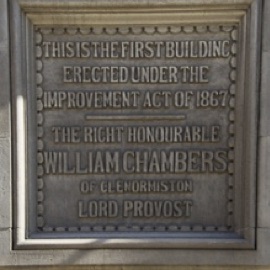2 St Mary’s St, EH8 8AA

2 St Mary’s Street was the first building erected under the 1867 Edinburgh Improvement Act. The act was the achievement of William Chambers (1800-1883), Lord Provost of Edinburgh and Sir Henry Duncan Littlejohn (1826-1914), the first Medical Officer of Health for the city. In 1765, Littlejohn published his Report on the Sanitary Condition of the City of Edinburgh, in which he demonstrated, using innovative statistical methods, the effects of population density, poverty, and sanitary conditions on the health and life expectancy of people. The Report helped persuade city officials to act. Legislation was passed to widen streets, clear congested housing sites, improve water supply, and monitor more closely the quality of food, among other things. However, in practice, the Improvement Act was used to legally demolish the poorest tenement dwellings in Old Town, which were replaced by housing for artisans, tradesmen, and the `superior` working classes. The large-scale slum clearance, although celebrated for its sanitation improvements, reduced the amount of available housing and displaced much of the city’s poor, ultimately shifting, rather than solving, the housing problem.

photograph by Archibald Burns, 1871
(Scottish National Portrait Gallery)

(Scottish National Portrait Gallery)
Find out more
